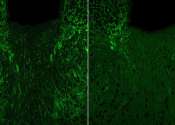A microbial compound in the gut leads to anxious behaviors in mice
A Caltech-led team of researchers has discovered that a small-molecule metabolite, produced by bacteria that reside in the mouse gut, can travel to the brain and alter the function of brain cells, leading to increased anxiety ...






